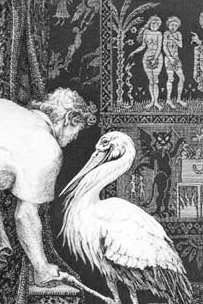I have a new squatter in the yard today, a surprising and impressive addition to the menagerie.
I first noticed the web on the clothesline (yes we are retro) as I was talking to my wife on the porch. My first impression was "What the hell ... ?" When we finished discussing the schedule for the day I got out of my chair and went to take a closer look.
The spider was sitting in the middle of the orb. I saw immediately that she was not the usual type of spider, the yellow garden spider (Argiope aurantia), that I see in the backyard. Her legs were shorter and the coloring much different. But she was skittish. She didn't like my magnifying glass at all. Checking the databases later I wasn't sure if she was the spotted orb spider (Neoscona domiciliorum) or the more common cross spider (Araneus diadematus).
But her web just stunned me.
Our clothesline is made of white woven cotton and runs between two pulleys that are six inches in diameter. It cuts across one end of the backyard, from the small porch by the kitchen door to a pole about 30 feet away. It is fairly taut so the six inch gap between the upper and lower run stays consistent.
Her web was constructed in the middle of the line, situated perfectly in an area where the prevailing breezes would guide her prey right into the net. Her web was a more haphazard spiral than the yellows', and there were gaps where prey had struggled. By the size of the holes, I assumed that their struggles were in vain.
But that's not what had surprised me. You see, the web hung suspended from the lower run of the clothesline and was anchored by a single thread to the ground. The distance from the cord to the ground was fully six feet!
In the middle of the night, a small dark spider had climbed the peeling white-painted wooden frame of a kitchen door looking for a place to start the web. She probably hesitated a bit at the vibrations transmitted to the pulley from the light breeze blowing across the cord, but, when nothing threatened, she moved across the pulley and out onto the clothesline glowing whitely in the moonlight.
She carefully moved along the cord. About halfway across, she found a place that suited her. She spun a small amount of silk and attached it to the cotton, then spinning the silk as she went. lowered herself to the ground. She found a stiff stubby stalk of hawkweed, left after a recent mowing, and anchored her silk to it.
Then she climbed back up. For someone of my height, it would be like climbing straight up a 75-foot rope. At the top she moved about two feet further out along the line to attach another line, then walked back and descended the first line spinning her thread all the way to attach the new thread about three feet down. Then she did the same on the other side.
Spiders generally take advantage of the surrounding structures to anchor the main framing cables of their webs, but, for some reason, our little friend decided to do it the hard way. Using the anchor line and the two lines angling down at about 45 degrees to it, she started creating the radii of her web; the non-sticky spokes to hold the sticky spiral.
Every few inches along the huge double triangle she had created, she attached another silk thread then, trailing the silk slackly behind her, walked along the closest path to a point midway between the downward pointing apex and the clothesline, tightened it up and secured it. Then up she climbed back up to do the next line repeating the process until she had nearly 30 spokes. She then created a non-sticky spiral, moving from spoke to spoke with a slack thread then tightening and attaching it.
With this spiral complete, she stopped for a short time, whether to rest or perhaps change the chemistry of her body to produce a different kind of silk. Then using the non-sticky spiral and the spokes as pathways she started to lay down her sticky threads. Sometimes, in the more widely spaced areas she would move back and forth in the same area before moving on to a new one.
Finally done she moved to the center of the web to wait.
By the time I saw her, the web was looking a little ragged. I hope that meant she had eaten well.
I went into my study to try to identify her from my brief glimpse. When I went back out to double check her markings, the breeze had stiffened, her anchor line had parted, the web was gone and she was nowhere to be seen.
Perhaps she'll be back tomorrow.
For a more scientific explanation of this impresive feat, you should look at the explanation of web-building by Samuel Zshokke.
For a wonderful and more 'old school' description I suggest one of my heroes Henri Fabre whose description of the process is in "The Life of the Spider" Chapter IX: The Garden Spiders: Building the Web.



